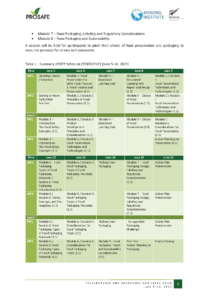
Food is an ideal medium for the growth of microorganisms which warrants measures to preserve food safe for consumption over a specified period of time also called preservation. In commercial setting food preservation has gone beyond safety and includes preservation of nutrients and appearance to strengthen competitiveness for wider market access. Under these circumstances, safe food value chain applies the combined benefits of preservation and packaging to ensure that consumers enjoy safe and quality food.
Good manufacturing practices (GMP) or Good Agriculture Practices (GAP) are pre-requisite programs for food preservation to achieve its safety and quality objectives. Food industry in developing countries are faced with constant challenges to control safety of food mainly against microbiological hazards. The industry is constantly finding new and cost-effective methods that are less intensive with food, with lower energy consumption and more effective against various food hazards to meet increasing consumer demand for food with low additives or food which use natural additives.
Packaging protects food from damage and contamination all through the supply chain. Packaging plays a significant role in delivering safe and quality fresh produce to consumers through distribution systems and can only be effective if pre-requisite programs such as GMP and GAP are complied with. Yet, any packaging, basic or sophisticated cannot fulfill food safety and quality objectives without effective preservation and good hygiene practices.
There are a variety of materials developed for food contact materials (packaging and food receptacles). Some have different gas permeabilities, different resistances and permissiveness to light, those that indicate if temperature has been constant during storage, or if there have been breakages of the cold chain and the concentration and composition of the gas inside the packed food. As a result, most packaging solutions are derived from synthetic materials which have raised health risk concerns and become a bane to solid waste management.
Health risks of materials and chemicals used in food packaging need to be carefully controlled. Carcinogens, toxic chemicals, mutagens, etc. need to be eliminated from food contact and potential migration into foods. More environment-friendly solutions are being developed ranging from extended producer responsibility (EPR) to biodegradable packaging materials.
The small domestic demand and lower awareness of food safety and quality among developing country consumers limit investments in effective packaging solutions in developing countries. This often limits the ability of FBOs in these countries to enhance product quality to meet standards of international market and increasingly domestic market in some fast-developing countries.
On April 12th, 2021, The Prepared Foodstuffs Product Working Group (PFPWG) of the Association of Southeast Asian Nations (ASEAN) launched two guidelines on the control of food contact materials (FCMs). These are:
- ASEAN General Guideline on Food Contact Materials; and
- ASEAN Guidelines for Good Manufacturing Practice for Food Contact Materials.
The General Guideline on Food Contact Materials targets food business operators (FBOs) and outlines the use of safe food packaging, the traceability system to ensure FCMs comply with trade guidelines, and placement of FCMs within the ASEAN market.
The Guidelines for Good Manufacturing Practice for Food Contact Materials targets FCM manufacturers and FBOs. The guideline defines terms relative to the manufacturing of FCMs including good manufacturing practice (GMP) and outlines quality assurance system for FCM manufacturers and users.
ASEAN’s PFPWG expects to prioritize the development of specific measures for 17 groups of FCMs notably active and intelligent materials and articles, printing inks, regenerated cellulose, silicones, textiles, varnishes and coatings and wood.
The ASEAN Principles and Guideline for the Establishment of Maximum Use Level for Food Additive and relevant guidelines under the ASEAN Common Food Control Requirements (ACFCR) help support ASEAN Member States (AMS) including CLMV countries in improving national food control system for regional trade facilitation. It is important for FBOs in AMS to be up to date with latest food control requirements which may have an effect on their processing, packaging or labeling practices.
Studies on preservation and packaging in developing countries highlight the need to increase greater awareness on the role of packaging in reducing losses, improve food safety and preserve nutrients and improve marketability of food products. Capacity building on food preservation and packaging technology for small FBOs should ensure that food safety is not compromised in pursuit of commercial objectives.
Supermarkets and other modern retail outlets are among the key features of expanding urbanization of ASEAN Member States (AMS) including Cambodia, Lao PDR, and Viet Nam. To remain in businesses, the domestic FBOs are looking to improve the quality and safety of their food products. The ability to understand the mechanism of food spoilage and the environment contributing to it enables FBOs to determine the most effective and preservation and packaging solutions.
The new regional guidelines and future ones offer support to small and medium FBOs in the AMS to further improve product quality and safety in cost effective manner. FBOs need support in terms of knowledge exchange and sharing in these areas. Regular capacity building interventions to better understand the evolving nature of the food preservation and packaging technology will help small and medium FBOs to stay competitive and expand their market opportunity.
The 10-day Regional Training Program (RTP) on Preservation and Packaging for Safer Food is funded by the New Zealand Aid Programme (NZAP) and organized by the Mekong Institute (MI). It is aimed at:
- Strengthening knowledge and understanding on the selection of food preservation, packaging and labeling for safe and quality food;
- Enhancing knowledge on food safety pre-conditions for effective food preservation and packaging;
- Promoting application of best practices in food packaging with sustainability considerations for safer food.
At the end of the training participants will learn:
- Methods and approaches on cost effective application of food preservation and packaging methods;
- Best practices in complying with food labeling requirements;
- Channels to obtain accurate regulatory information related to food preservation and packaging;
- Approaches to achieve both food safety and commercial objectives in relation to food preservation and packaging.
The training is targeted at representatives of the private sector from Cambodia, Lao PDR, Myanmar, and Viet Nam are encouraged to apply. It is also useful to private sector in the fresh produce sector aiming to minimize food loss and cross contamination. Food regulators and researchers from institutes of higher learning are also invited to attend the training to build their capacity to support the private sector in the choice of food preservation and packaging for safe and quality food products.
The training program will cover eight modules i.e:
- Module 1 – Introduction to Food Safety Concepts
- Module 2 – Food Preservation for Safer Food
- Module 3 – Choice of Food Preservation (Participants’ Presentation)
- Module 4 – Structured Learning Visit
- Module 5 – Regulatory Considerations for Food Preservation
- Module 6 – Food Packaging: Types and Materials
- Module 7 – Food Packaging, Labeling and Regulatory Considerations
- Module 8 – Food Packaging and Sustainability
A session will be held for participants to pitch their choice of food preservation and packaging to resource person/s for advice and comments.



